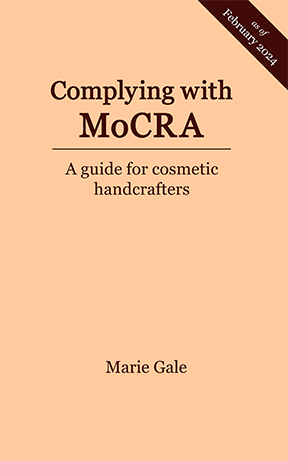What are fragrance allergens? Do they need to be included in the ingredient declaration for a cosmetic product? (Answer: Yes, in most countries, but not in the US … yet.)
Fragrance Allergens
Fragrance allergens are components in fragrances that are known to be a likely cause of allergic reactions in an appreciable percentage of people. In other words, while it’s possible that any component of a fragrance could cause an allergic reaction in one person, there are some components that have been proven to cause an allergic reaction in a lot of people.
Fragrance allergens can be synthetic fragrance components or components in natural, plant-based fragrances (“natural complex substances”) or essential oils, concretes, absolutes or extracts. For example, linalool is a known fragrance allergen, and lavender essential oil contains about 35% linalool. The list at the bottom of this article shows the possible plant-based sources of some known fragrance allergens.
Ingredient Declaration
Some countries (see list below) have regulations that require that certain fragrance allergens be listed in the ingredient declaration if there is a minimum amount in the product:
- In rinse off products: 0.01%
- In leave on products: 0.001%
In other words, if your lavender cream has 0.001% linalool in it, then in those countries you would need to list linalool in the ingredient declaration.
Europe & the UK
Currently, Europe and the UK require that all of the fragrance allergens in the list below be identified in the ingredient declaration if they are present at the minimum amounts—with the exception of Butylphenyl Methyl Propional and Hydroxyisohexyl 3-Cyclohexene Carboxaldehyde.
However, there is a proposed an amendment that added 54 additional fragrance allergens to the list and they will also need to be declared if they are present. It is unclear if (or when) the proposal will go into effect.
[Update] The EU regulations were finalized and the additional 54 fragrance allergens are now in the regulations. They need to be added to product labels by either July 2026 or July 2028, depending on when the product was placed on the market.
United States
Currently there are no fragrance allergens identified in regulations that must be included in the ingredient declaration.
However, under the new cosmetic law (MoCRA), the FDA must identify fragrance allergens of issue and then create regulations to require them to be included in the ingredient declaration. The FDA has until June 2024 to issue the proposed regulations, and the final regulations must be issued within 180 days of the close of the comment period.
[Update] The FDA missed the June 2024 deadline, but has said that the proposed regulations will be published in October 2024.
It’s likely that the fragrance allergen list will be similar to the list already adopted by other countries (but that’s not definite).

Shameless plug!
To find out how MoCRA applies to you, what you need to do, and when you need to do it by, get my book from Amazon and use it.
Up to date as of May 2024.
California
California requires that cosmetic products containing fragrance allergens be reported to the through the California Department of Public Health’s Safe Cosmetics Reporting Portal. Currently the same 24 fragrance allergens required on the labels in Eurpoe must be reported. They will require reporting of the additional 54 fragrance allergens at the same time that they must be included on the labels of products in in the EU. For more data on the California requirements see California Allergen Reporting.
Canada
Currently, Canada does not require any specific fragrance allergens that must be included in the ingredient declaration.
However, in February 2023 new rules were proposed to require the same allergens as the EU to be included in the ingredient declaration. As of this writing, they have not yet been finalized nor gone into effect.
[Update] The Canadian regulations were finalized in April, 2024. The 24 fragrance allergens that are already in the EU list must be added to Canadian cosmetic ingredient declarations by April 12, 2026. The additional 50 or so fragrance allergens added to the EU list in 2023 have to be on Canadian labels by August 2026 or August 2028, depending on when the product is or was introduced onto the market.
India & New Zealand
India and New Zealand both require that all of the fragrance allergens on the list below be included in the ingredient declaration if they are present.
S. Korea
South Korea requires all the fragrance allergens on the list below be included in the ingredient declaration—except Hydroxyisohexyl 3-Cyclohexene Carboxaldehyde.
United Arab Emirates (UAE)
The UAE doesn’t have a list of specific fragrance allergens, but they require that any aromatic substance present in perfume at over .001% must be identified in the ingredient declaration.
Hong Kong, China’s Taiwan, Japan, ASEAN1
There are no requirements for listing fragrance allergens in the ingredient declaration.
What Should You Do Now?
If you sell your product in any of the countries listed above that currently have fragrance allergen requirements, you should be including the correct information in your ingredient declaration (if any of the fragrance allergens are present at the minimum amounts).
If you sell in the United States or Canada, you should determine if any of your products contain the fragrance allergens, and if so, at what amounts. That way you will know if you need to update your ingredient declarations when the regulations are issued or updated. Of course, knowing what fragrance allergens are in your products is a good idea anyway!
Your fragrance oil provider should be able to provide you with the amount of any of these fragrance allergens in the fragrance oils you purchase. For plant-based essential oils, concretes, absolutes, or extracts, you can ask your essential oil provider or check the “Natural Complex Substances” list. (On that page you’ll need to click on “IFRA 51st Amendment – Annex on contributions from other sources“, which will download to your cmoputer an Excel spreadsheet with the list. It’s the only way to view it.) You’ll have to do the math based on the amount of the fragrance/essential oil you use, the percentage of the allergen in the fragrance/essential oils, and whether your usage meets the minimum which would require inclusion in the ingredient declaration.
Regulated Fragrance Allergens
| Fragrance Allergen | Source | Plant Sources |
| Alpha-Isomethyl Ionone | Synthetic | n/a |
| Amyl cinnamal | Synthetic | n/a |
| Amyl cinnamyl alcohol | Synthetic | n/a |
| Anisyl (Anise) alcohol | Synthetic or Natural | Honey, Anise, Tomatoes, Tahiti Vanilla |
| Benzyl alcohol | Synthetic or Natural | Peru Balsam, Tolu Balsam, Jasmin, Apricot, Almond, Apple, Asparagus, Banana, Black Currant, Blackberry |
| Benzyl benzoate | Synthetic or Natural | Peru Balsam, Tolu Balsam, Jasmin, Ylang-Ylang |
| Benzyl cinnamate | Synthetic or Natural | Peru Balsam, Tolu Balsam, Copahu |
| Benzyl salicylate | Synthetic or Natural | Propolis |
| Butylphenyl methyl propional | Synthetic | n/a |
| Cinnamal | Synthetic or Natural | Cinnamon, Hyacinth, Patchouli, Nutmeg |
| Cinnamyl alcohol | Synthetic or Natural | Hyacinth |
| Citral | Synthetic or Natural | Lemon, Orange Peel, Eucalyptus, Grapefruit, Orange, Celeris, Apricot, Blackcurrant, Grape, Kiwi, Mango, Ginger, Melon, Plum, Raspberry, Rose |
| Citronellol | Synthetic or Natural | Lemongrass, Ceylon, Apple, Apricot, Cassis, Blackberry, Blueberry, Orange, Passion Fruit, Peach, Rose |
| Coumarin | Synthetic or Natural | Woodruff, Clouves, Sweet clover, Angelique, Berce |
| Eugenol | Synthetic or Natural | Clove, Allspice, Bay (Myrcia acris), Avens, Ceylon Cinnamon, Laurel, Cistus, Labdanifere, Basil Sassafras, Basil Java, Cassie, Sweet Flag, Carnation, Boldo, Cascarille, Galangal, Bay Leaves, Nutmeg, Pale Rose, Ylang-Ylang, Marjoram, Calamus, Camphor, Lemongrass, Patchouli |
| Farnesol | Synthetic or Natural | Rose, Neroli, Ylang-Ylang, Lime, Tolu Balsam |
| Geraniol | Synthetic or Natural | Rose oil, Orange, Palmarosa, Verbena, Neroli, Lemongrass, Hyssop, Laurel, Lavender, Mandarine, Melissa, Myrtle, Apple, Apricot, Black Cranberries, Blackcurrant, Blackberry, Coriander, Ginger, Nutmeg, Thyme, Geranium, Rose, Palmarosa, Ylang-Ylang |
| Hexyl Cinnamal (Cinnamaldehyde) | Synthetic | n/a |
| Hydroxycitronellal | Synthetic | n/a |
| Hydroxyisohexyl 3-Cyclohexene Carboxaldehyde (Hydroxy -methylpentyl-cyclohexenecarbox aldehyde) | Synthetic | n/a |
| Hydroxycitronellal | Synthetic | n/a |
| Isoeugenol | Synthetic or Natural | Citronella, Essential Oils of Ceylon, Essential Oils of Ylang-ylang |
| d-Limonene | Synthetic or Natural | Lemon, Dill, Common Juniper, Orange, Verbena, Neroli, Niaouli, Melaleuca, Lemon Balsam, Peppermint, Nutmeg, Myrrh, Angelique, Aspic, Badiane, Bergamot, Mandarin, Bigaradier, Caraway, Celery, Lavender, Lime |
| Linalool | Synthetic or Natural | Lavender, Pine, Laurel, Sour Orange, Marjoram, Peppermint, Lemon, Orange, Ylang Ylang, Verbena, Myrtle, Neroli, Coriander, Geranium, Lime, Lemon Balsam, Nutmeg, Lemongrass, Basil, Bergamot, Rosewood, Banana, Blackberry, Bean, Blueberry, Apple, Apricot, Artichoke, Thyme, Rose, Palmarosa |
| Methyl 2-Octynoate | Synthetic | n/a |
| Oakmoss Extract | Natural | Oak moss extract |
| Tree moss extract | Natural | Tree moss extract |
- Association of Southeast Asian Nations, which includes Brunei, Cambodia, Indonesia, Laos, Malaysia, Myanmar, Phillippines, Singapore, Thailand and Vietnam ↩︎


Leave a Reply